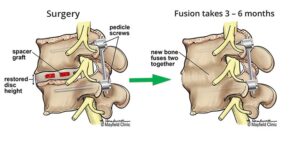Introduction
Keyhole spine surgery, also known as minimally invasive spine surgery or endoscopic spine surgery, is a surgical technique used to treat various spinal conditions. It involves making small incisions and using specialized instruments and a camera (endoscope) to access and treat the spine. The goal of keyhole spine surgery is to minimize tissue damage, reduce postoperative pain, shorten recovery time, and improve overall outcomes.

How Keyhole Spine Surgery Works
Keyhole spine surgery typically involves the following steps:
Anesthesia: Before the procedure, you will be given anesthesia to ensure your comfort and minimize pain. The type of anesthesia used will depend on the specific procedure and your individual needs.
Incisions: Small incisions, usually less than an inch in length, are made in the skin near the affected area of the spine.
Endoscope Placement: An endoscope, a thin tube with a camera and light source at the tip, is inserted through one of the incisions. The camera provides visual guidance to the surgeon, who views the images on a monitor.
Access and Treatment: Specialized instruments are inserted through the other incisions to perform the necessary surgical steps. These instruments may include probes, retractors, and surgical tools.
Tissue Preservation: Keyhole spine surgery aims to preserve surrounding tissues by carefully maneuvering around them rather than dissecting or removing them. This helps to minimize tissue damage and promote faster healing.
Closure: Once the surgical procedure is complete, the incisions are closed with sutures or adhesive strips.
Postoperative Recovery: After the surgery, you will be closely monitored in a recovery area to ensure your stability and comfort. Pain medications and other supportive measures will be provided as needed. The recovery period for keyhole spine surgery is typically shorter compared to traditional open surgery.
When Keyhole Spine Surgery is Needed
Keyhole spine surgery may be recommended for various spinal conditions, including:
- Herniated Disc: When a disc in the spine protrudes or bulges, causing nerve compression and pain.
- Spinal Stenosis: Narrowing of the spinal canal, which can lead to nerve compression and pain.
- Spinal Deformities: Keyhole spine surgery can be used to correct certain spinal deformities, such as scoliosis or kyphosis.
- Spinal Tumors: In some cases, keyhole spine surgery can be performed to remove or biopsy spinal tumors.
- Spinal Fusion: Keyhole techniques can be used in certain cases to perform spinal fusion, which involves joining two or more vertebrae to provide stability.







